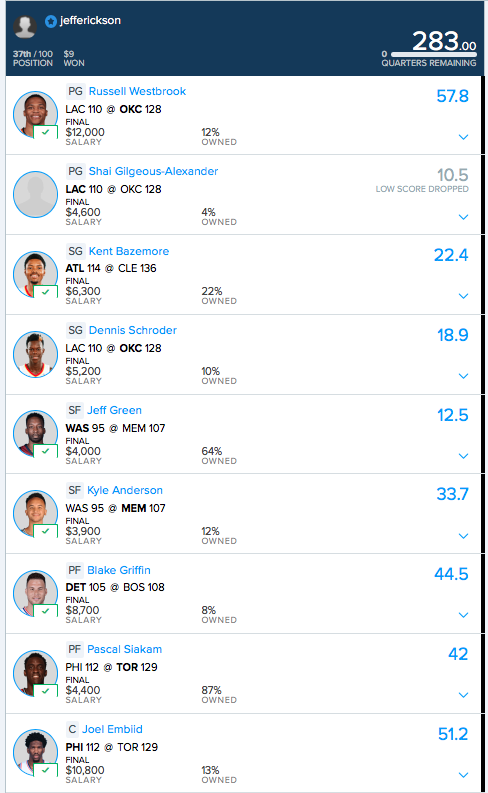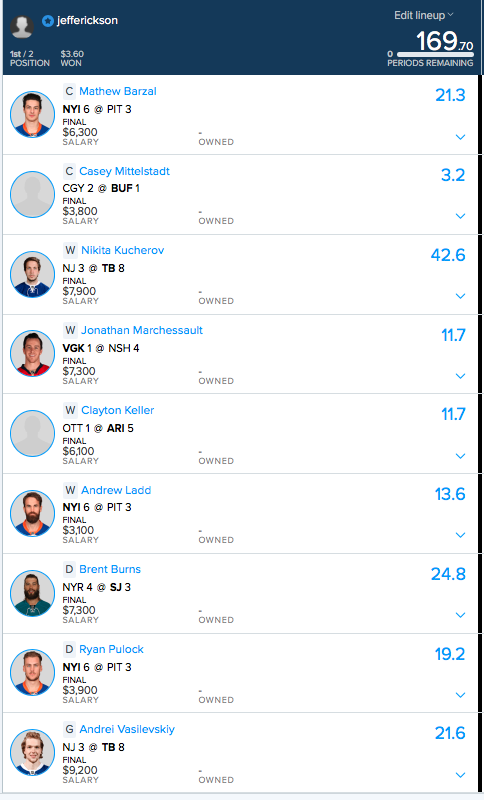When it comes to fantasy basketball and fantasy hockey, I know just enough to be dangerous to myself. I'm in one long-running league in each sport. The NBA league - the Snide Rotisserie League - dates back to 1997. I was in law school, and I started the league with my best friend from college, a few other college friends and a few law school buddies. We scored the league by hand and sent out a weekly report called "Snide Remarks," where we'd comment on the games, about each other, and had recurring themes like the Kevin Johnson Injury of the Week (my favorite - Sega Thumb). Yeah, we were total nerds. Insert your own snide remark here .... It's a head-to-head points league, starting just six players, both aspects remnants of how long ago we started it. So it's not very representative of what the majority of the fantasy hoops universe plays.
My hockey league is the PHL (formerly the THL, but renamed after former RotoWire writer and league-mate Dan Pennucci, who suddenly passed away a couple of years ago). It originally was comprised of a bunch of RotoWire guys and LA Times guys, but has since morphed into being mostly RotoWire guys and friends thereof. It's a keeper league (three players must be kept from each team), and also a unique format - head-to-head, where we play only when the NHL has seven or more games on a given night. So yeah - it's also unique and not as deep as many of the leagues out there.
In both cases, I don't dig deep enough to do well in DFS, not without additional help. Enter RotoWire's DFS Tools, that helped me do pretty well in basketball last season. Frequently I'll just use our Optimizer without any changes, other times I'll lock in a player or two, or exclude a player or two - I had a firm "No Carmelo Anthony" rule that served me pretty well.
This year I decided to be a little bit more transparent about my process and results. It'll help me track how well our tools are doing, and force me to be better about my record-keeping. Last year I was really good about tracking my inputs and results for about 7-to-8 weeks, but as baseball rolled around it became increasingly difficult for me to stay on top of it. This year I think that writing will help me do a better job of tracking.
This is also about money management and game selection. In my opinion, DFS is similar to poker in that you need those two skills as well to be profitable. It's not just a matter of picking lineups. I'm not making my living strictly off of playing, but I need to be responsible about how I play. Hopefully that's relatable to you as you play, if you play and follow along.
Here are a few principles of this experiment:
- I'm starting with a $500 bankroll for hoops and hockey purposes. It's by design that I'm not playing very high - I think that's how most people play, though many have aspirations to ultimately play higher levels.
- On any given night, I don't want to have more than 20% of my bankroll in play. Preferably I'd limit it to no more than 10% per sport, but I'm not going to be hard-fast about that rule.
- I want at least half my action on a given night to be in "cash" games - 50/50's and H2H's, for me. It's been my experience that head-to-head's are vital for my bankroll management. Even on your worst nights, it's still possible to win a few contests to cushion the blow.
- While "FOMO" is a real and damaging thing in DFS (and life!), I can't completely stay away from GPP's. But most of my exposure here will be in 100-man contests and single-entry contests. I won't completely shy away from all big prize, high-entry tournaments, but given that there are so many people putting tons of entries into those contests, the odds are exceptionally low that I'll top them. That's especially true when I'm using an optimizer as a base lineup builder - it'll be great at finding good plays, but it's also going to be difficult to be unique.
I started this last night, with more hockey exposure than basketball exposure. This night, with just one NHL game, I'm not going to play DFS hockey.
Here are my results from last night (all action was on FanDuel, though I'm not exclusively playing there, that's usually my preferred site):
Basketball:
First, here's my lineup:

This was done strictly using the Optimizer, with no alterations. I entered a $5 50/50 contest, $2 100-man contest (top-12 pay), three $1 h2h's, one $2 h2h, one $5 h2h, and a $5.55 GPP, for a total of $22.55. It scored 283 points, and I cashed out $14.40, so that came at a net loss of $8.15. My winning entries were the 50/50, one of the $1 h2h's, and the $2 h2h. I lost everything else. I won't go into the lineup analysis at this point - I want more results before I start drawing too many conclusions.
Here is my spreadsheet entry for the day:

I'm going to try to post these on a regular basis.
Hockey:
I entered three lineups and thus many more contests last night.
Lineup #1 - straight up Optimizer, no alterations:

This one did really well. I won all my head-to-head matchups, and I cashed in a GPP with this. Unfortunately, I had this entered in a $5 50/50 and a $2 100-man contest which didn't fill. This happened despite entering almost two hours before roster lock. I quickly have learned that the volume in hockey isn't nearly as high as it is in basketball. If I want to get multiple lineups in my hockey contests, I need to act even earlier.
Lineup #2:

We recently hired Russ Prentice, who is a really good hockey DFS player, to write twice weekly columns for us on Tuesdays and Thursdays, when the schedule is heaviest. Using his work, I wanted to build a stack and then combine that with the Optimizer to fill the remaining spots. This was a Sharks stack. Fortunately every contest I entered with this lineup filled, and I cashed in every lineup, though the GPP and the 100-man contests were essentially min-cashes.
Lineup #3:

Finally, I entered a stack with the Penguins' second line, at home, which has been super-chalky and strong lately, combined with the optimizer. Again, the 100-man I entered with this one didn't fill. FanDuel has an option to allow up to three entries in their 100-man contests, and perhaps I should have entered all three in the same contest. My thinking in doing three separate ones was that (a) I thought that all three would fill, which clearly they didn't, and (b) I'd lower the variance a little bit in case one was substantially more difficult to cash in than the others. I won four of my five head-to-heads, cashed in my 50/50, but fell short in my GPP.
All-in-all I was in for $48 (though I had hoped to be in for $57), and cashed out for $87.20, good for a profit of $39.20.
Here's my spreadsheet entry for the day:

Wednesday Night's Action:
The NHL has just one game, so I'm avoiding those contests, and just playing NBA. I have two NBA lineups, for a total of $52 - $26 apiece. One is using the optimizer with no adjustments, and the other is locking in Karl-Anthony Towns (under the theory that without Jimmy Butler in there he'll thrive) plus Kyle Kuzma (I wanted a piece of the Lakers' game without paying up for Lebron).
Here are my two lineups:
Lineup #1 - Optimizer, No Adjustments:

Lineup #2 - Towns + Kuzma

At least for one night, it appears my adjustments are actually adding value, though I'm not sure if it'll be enough. Stay tuned!



